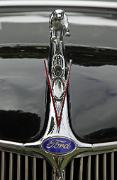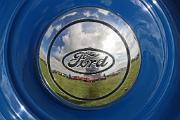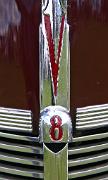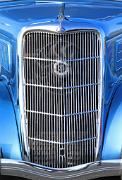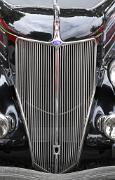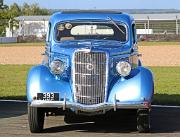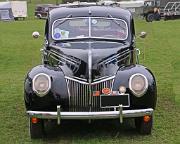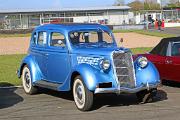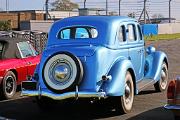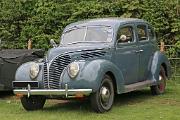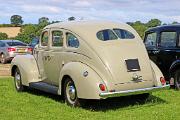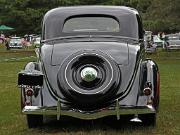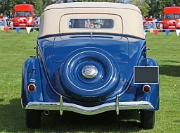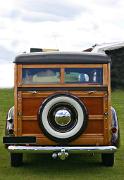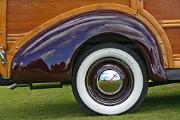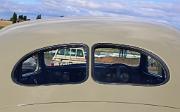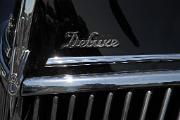
aa Ford Model 48 Deluxe 1939 badge
Ford Deluxe 1938 - badge on bonnet. In 1937 Ford wanted to elevate the 'Deluxe' model towards Lincoln, separating it from the 'Standard' model which was sometimes only given the restyle from the previous year Deluxe. In 1939 Ford created the 'Mercury' brand and gave the 'Standard' model a six cylinder engine in place of the unloved small V8.
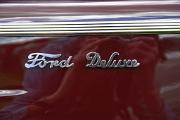
aa Ford Model 101A Deluxe 1940 Station Wagon badge
Ford Deluxe 1940 Station Wagon - badges on bonnet side
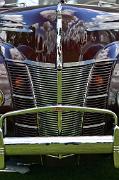
ab Ford Model 101A Deluxe 1940 grille
Ford Deluxe 1940 Station Wagon. The low v-shaped grille with horizontal bars differentiate the 1940 Ford Deluxe V8 from the 1939 model which had vertical bars. The 1940 model also has grille panels infilling between the grille and the wings (fenders)
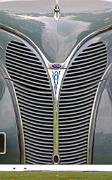
ab Ford V8 Model 81A 1938 grille
Ford V8 Model 81A 1938. Only the Deluxe models for 1938 had the heart-shaped grille
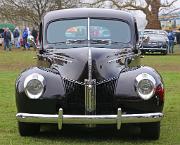
ac Ford Model 102A 1940 V8 Standard Tudor head
Ford Model 02A 1940 V8 Standard Tudor. Bob Gregoire reworked the front of the 1940 Fords, with sealed beam headlamps and revised grille. The 'Standard' models now had simpler grilles and unchromed trim (customised to chrome here), whereas as the Model 01A Deluxe models had side grilles and chromed trim. The 'Standard' was now offered with the 3,622cc V8 as an option to replace the 60bhp 2,229cc V8
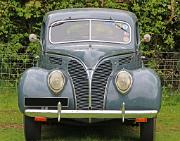
ac Ford V8 Model 81A 1938 Fordor Sedan head
Ford V8 Model 81A 1938 Fordor Sedan. The heart-shaped grille denotes this as the Deluxe model because the Standard model retained 1937 styling. Ford offered the 2,229cc flathead V8 in the cheaper Model 82A and the existing 3,622cc in the Model 81A and Deluxe
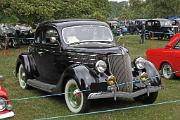
Ford Model 48 1936 5-window Coupe front
Ford V8 1936 5-window Coupe. Holden 'Bob' koto restyled the front of the 1935 Model 48 Ford V8 (styled by Phil Wright)
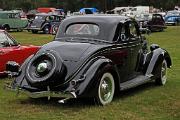
Ford Model 48 1936 5-window Coupe rear
Ford Model 48 1936 5-window Coupe. The 5-window coupe has a single pane rear window, twin front screens and the window in the door plus the little side window in the c-pillar. There was also a 3-window coupe which had a longer door and no window in the c-pillar.
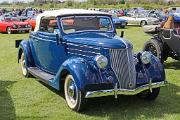
Ford Model 68 1936 Cabriolet Deluxe front
Ford Model 68 1936 Cabriolet Deluxe. The engine was a 3,622cc flathead V8 engine developing 85bhp.
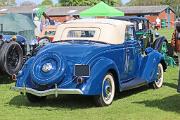
Ford Model 68 1936 Cabriolet Deluxe rear
Ford Model 68 1936 Cabriolet Deluxe. The V8 Model 68 for 1936 was extensively facelifted by Bob Koto from the 1935 design by Phil Wright; both worked for Briggs Manufacturing as Ford did not do its own bodies at this time. The 1935 Ford V8 chassis had grown over 5-inches to 112-inches and was carried forward to the 1936 cars
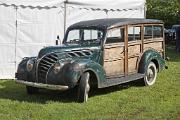
Ford Model 81A 1938 Deluxe SW front
Ford Model 81A 1938 Deluxe SW. Powered by the 85bhp 3,622cc Flathead V8 engine. The 'heart-shaped' grille was new for 1938 (by Bob Gregoire) but was only given to the Deluxe models, as from this year the Standard models were differentiated from the Deluxe.
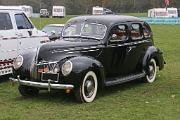
Ford Model 91A V8 Deluxe 1939 Fordor front
Ford Model 91A V8 Deluxe 1939 Fordor. The venerable 3,622cc V8 continued now in 90bhp format, although there was also a Model 922A 'Standard' Ford V8 with 60bhp V8
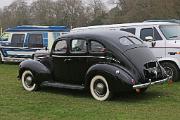
Ford Model 91A V8 Deluxe 1939 Fordor rear
Ford Model 91A V8 Deluxe 1939 Fordor. Deluxe bodies were given a Torpedo tail for the sedans, whereas Standards cars had a shorter 'bustle' back design.
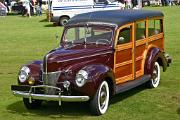
Ford Model 101A Deluxe 1940 Station Wagon front
Ford Deluxe 1940 Station Wagon. In 1938 Ford USA tried to create an upmarket brand 'Deluxe Ford', this is an example of the 1940 Deluxe Ford V8 with 4-door Station Wagon body 'Woody' Britain produced a similar range of V8 cars but based more on the standard Ford V8 cars.
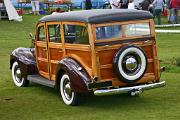
Ford Model 101A Deluxe 1940 Station Wagon rear
Ford Deluxe 1940 Station Wagon. It is easy to see why Station Wagons (an American term for 'Estate Cars') were called 'Woodies'. Unlike other manufacturers, Ford built its own Station Wagons, and in 1937 opened a special plant at Iron Mountain for these Woodies.
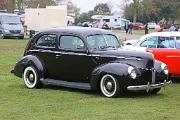
Ford Model 102A 1940 V8 Standard Tudor front
Ford Model 02A V8 Standard Tudor 1940. Bob Gregoire a reworked the front of the 1940 Fords, with sealed beam headlamps and revised grille. The 'Standard' models now had simpler grilles and unchromed trim (customised to chrome here). The practice now was to give the 'Standard' models the fronts given the previous year to the Deluxe models, but with trim changes.
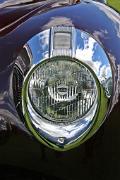
l Ford Deluxe 1940 lamp
Ford Deluxe 1940 - headlamp. These headlamps were the new sealed beam units in 1940, replacing fairer lamps that were used in 1937, 38 and 39.
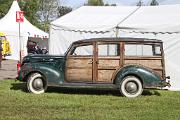
s Ford Model 81A 1938 Deluxe SW side
Ford Model 81A 1938 Deluxe SW. 6,944 Station Wagons were built on the 1938 Ford V8, and these were only available as 'Deluxe' specification and for the first time were sold as cars rather than commercials.
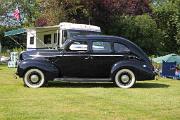
s Ford Model 91A V8 Deluxe 1939 Fordor Sedan side
Ford Deluxe 1938. This Fordor body shows the fashionable 'Torpedo' shape that Ford adopted for both the 2-door and 4-door Sedans. Ford intended the 'Deluxe' range to be higher-priced than standard Fords and less expensive than Lincoln. The body was designed for the 1937 model year by Alex Tremulis, Bob Koto, and Phil Wright under John Tjaarda at Briggs Manufacturing because Ford did not yet have its own styling office.
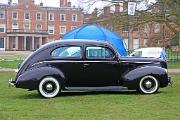
s Ford Model 102A 1940 V8 Standard Tudor side
Ford Model 02A 1940 V8 Standard Tudor. The 'Standard' 1940 Ford was simple, and usually came with a 2.2-litre 60hp V8, but also with the optional 85 bhp 3.6-litre V8. The 'Tudor' (2-door) body was now only offered on the Standard models. Wheels on this car are non standard, as is the lowered suspension.
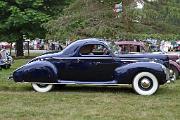
s Lincoln Zephyr V12 1939 side
Click here to go to an album on: Lincoln Zephyr. Lincoln Zephyr V12 1939. The Coupe (or 3-window coupe) was first offered in 1937, and shared the enormous 122 feet (3.1m) wheelbase of the 5.5metre long 4/5-seater Zephyrs. The Zephyr had been laid out by John Tjaarda as a streamlined car with a rear-mounted V8, but Bob Gregoire 'normalised' it as an aerodynamic car with front'mounted V12
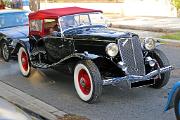
Jensen-Ford 1934 front
Jensen-Ford V8 1934. After actor Clark Gable commissioned the Jensen brothers to build a Ford V8 with Jensen coachwork, Ford gave the Jensen brothers an order for Jensen-Fords built on a modified Ford chassis with V8 engine.
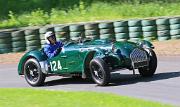
Allard J2X 1951 race
Click here to go to an album on: Allard J-Type. Allard J2X 1951. The 'J2X' has a 6-inch eXtended chassis over the J2, with changes to the front suspension and relocating the engine 7.5-inches further forward
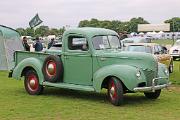
Ford Half Ton Pickup 1940 front
Ford Half Ton Pickup 1940. For 1940 E.T. 'Bob' Gregorie gave its pickups the same styling as the Ford cars, but trimmed down to 'standard' level. Power was provided by the Flathead V8, but for 1941 an new straight six engine was introduced which had more torque than the V8
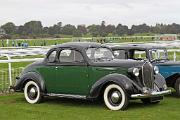
Plymouth P5 1938 front
Click here to go to an album on: Plymouth P5 and P6. Plymouth P5 1938 5-window Coupe. The P5 and P6 Plymouths were available with many body styles including 2 and 4-door sedans, 2-door coupe and even a dickey seat coupe, as well as a 7-passenger limousine.
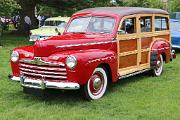
Ford Model 69A Super Deluxe 1946 Shooting Break front
Click here to go to an album on: Ford 1941. Ford Model 69A Super Deluxe 1946 Shooting Break. The Super Deluxe was given a 100bhp version of the 3,622cc Flathead V8
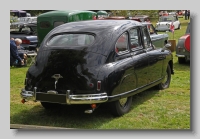
Standard Vanguard Phase I rear
Click here to go to an album on: Beetle-shaped cars. Standard Vanguard Phase I. The 'beetle-back' styling by Walter Belgrove only allowed a small boot, and the longer 3-box Phase II gave a more capacious body.
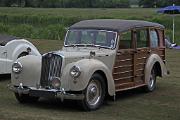
Lea-Francis Fourteen Station Wagon 1953 front
Click here to go to an album on: 'Woodies' (Station Wagons). Lea-Francis Fourteen Station Wagon 1953.
From 1951 the Fourteen was revised with lower bonnet and new wings incorporating the headlamps. By this time most Station Wagons were built by the AP Aircraft Company in Stoke Row
From 1951 the Fourteen was revised with lower bonnet and new wings incorporating the headlamps. By this time most Station Wagons were built by the AP Aircraft Company in Stoke Row
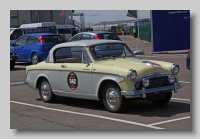
Sunbeam Rapier Series I 1955 front
Click here to go to an album on: Holden 'Bob' Koto. Sunbeam Rapier Series I. The 'Audax' models were launched at the 1955 London Motor Show with the Sunbeam Rapier designed by Holden 'Bob' koto at Raymond Loewy. Other models were released in 1956
All images and content of this site is the copyright of Simon GP Geoghegan
